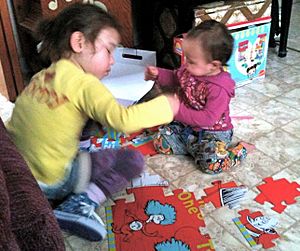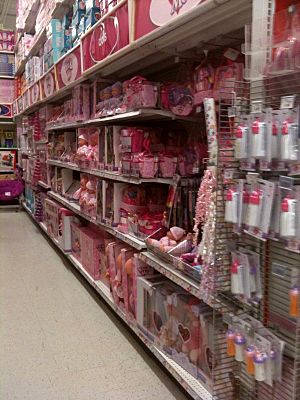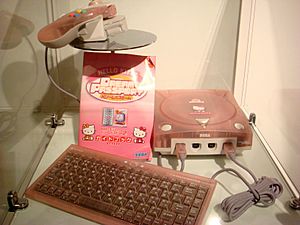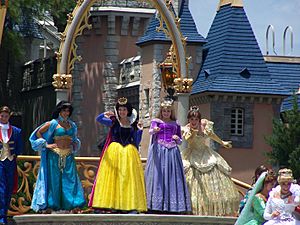Girls' toys and games facts for kids

Girls' toys and games are playthings and activities made especially for girls. The toy industry often creates these items with girls in mind. Sometimes, adults and kids see certain toys or games as being only for girls. This can be a way for girls to show who they are.
Contents
How Toys Get Gender Roles
Games and toys are often for everyone, no matter their gender or age. But in many cultures, some toys or games are given a "gender role." This means they are seen as either for boys (masculine) or for girls (feminine).
When a game has a gender role, it can sometimes mean that only boys or only girls are expected to play it. For example, in some European and American cultures, games like "mumblety-peg" (which uses a knife) were seen as a "boys' game" because they seemed dangerous. On the other hand, jump rope and clapping games were often seen as "girls' games." This idea of what's "right" for boys or girls can affect how toys are advertised.
Do Kids Grow Up Faster with Toys?
Today, children often move through different play stages more quickly than before. This is called "age compression." Girls, especially, seem to want more complex toys at a younger age. For example, Barbie dolls used to be for girls around 8 years old. Now, they are popular with girls as young as 3. The packaging for Barbie dolls even says they are for ages 3 and up.
Boys, however, often enjoy their toys for a longer time. They like toys they can build and take apart, or toys that move fast and involve fighting. One toy expert noted that girls often enter their "tween" phase (around 8 years old) and want different kinds of toys. Boys, though, might keep playing with traditional toys until they are 12. This means toy companies keep their boy customers longer than their girl customers.
Young girls are also interested in music, clothes, makeup, TV talent shows, and celebrities. Because of this, companies are changing how they make and sell products to them. Girls also tend to stay loyal to characters in toys and games for a longer time. Brands like Hello Kitty and the Disney Princess franchise have used this to market their products. Boys, in recent years, have started playing computer games at a younger age.
The "Pink" Trend in Toys
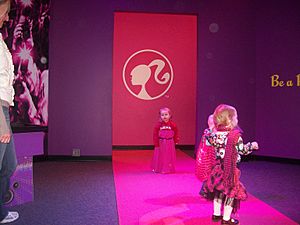
In Western countries, many girls' toys and games are now mostly pink. If you go to a toy store, you can easily spot the girls' section because it's full of bright pink products. This strong use of pink has caused some people to react against it. For example, one parent in Britain started a campaign called Pinkstinks. This campaign was against stores selling educational toys for girls only in pink.
Some people worry that using only pink for girls' toys makes gender differences too strong from a young age. They think it might focus too much on beauty and being quiet, instead of on fun and creativity.
It's not clear why girls might prefer pink. Some believe it's because of how they are raised (social conditioning). Girls might be surrounded by pink clothes and accessories from birth in some cultures. Others think a preference for pink might be "hard-wired" or natural. However, it's probably cultural. Less than a hundred years ago, pink was actually seen as a good color for boys!
Toy companies benefit from making clear differences between boys' and girls' toys. They have used marketing techniques for many years to divide children into groups. This is similar to how they market to adults. Some age groups, like "toddler," were actually created by clothing and toy makers to help sell more products.
Technology and Toys for Girls
Many toy companies have used technology to create popular toys that appeal to everyone. One example is the Tamagotchi toy, invented in Japan in the 1990s. This small, egg-shaped computer toy acts like a pet. You have to feed it and take care of it regularly. Millions of Tamagotchis have been sold worldwide.
Tamagotchi toys are still very popular with young girls. Newer versions are marketed to girls, letting them download new outfits and items using their cellphones.
In the 1990s, there was a trend of Girls' video games made just for girls. However, these games did not become very popular or sell well. One leading developer, Purple Moon, was even bought by Mattel in 1999.
More recently, in 2014, Moose Toys created Shopkins toys. These are small, about one inch in size, and are aimed at girls. Shopkins later released many games for phones and tablets. The game Shopkins World has been downloaded over 5 million times.
Video game sales have grown much faster than traditional toy sales in recent years. The Nintendo Wii is a well-known example of a game system that sells games for girls, boys, or both. Big toy companies like Hasbro have also started making game apps for smartphones. Children in richer countries are using these apps more and more.
Beauty Spas for Girls
Girls often show interest in beauty and grooming at a young age, even before they are 10. Many magazines for "tweens" (girls aged 9-12) have articles about mini-makeovers and manicures. Girls at this age often know a lot about different makeup products.
In recent years, many companies have opened stores in shopping malls that offer beauty experiences, not just toys. For example, Hamley's toy store in London opened a "Hair and Nail Bar" for girls in 2009. It became very popular with girls aged 7 to 8. Justice, a clothing store chain for preteen girls, also sells beauty and spa products.
In the United States, stores that focus only on makeup and spa experiences for preteen girls have been opening quickly. Tabby, for instance, is a chain that offers makeup parties in malls. This trend has continued even when the economy is tough. One study found that 62 percent of parents would rather spend less on themselves to spend money on their children.
Toy makers have also adapted to this trend by linking it to their doll products. The American Girl line of dolls has stores across the United States. These stores include a doll hair salon, a photo studio, and places to host parties. The Nickelodeon TV company's resort in Florida also has a spa for girls. This idea is working well around the world. The world's largest Barbie doll store in Shanghai has a "full-service day spa" where girls can get their hair cut and nails done. They can also buy clothes and accessories inspired by Barbie.
Images for kids
-
Detail from Children's Games by Pieter Bruegel the Elder (1560), showing Flemish girls playing popular games of the era
See also
 In Spanish: Juegos y juguetes de niñas para niños
In Spanish: Juegos y juguetes de niñas para niños


